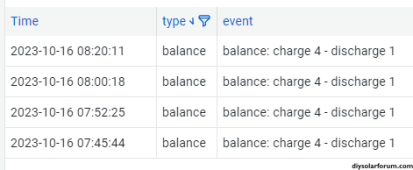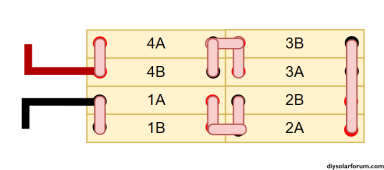Hi,
On my boat I have a 600Ah DIY 12V bank with Winston cells installed 6.5 years ago (cells with sequential serial numbers).
The cells are well top balanced and yesterday the voltage for one of the cells dropped suddenly by more than 100mV compared to the other cells... then later came back to same level as other cells. I cannot think of any reason to explain that behaviour, so I welcome any hypothesis.
See attached cell voltage and current graphs showing the weird voltage drop... and recovery
Cell #4 is the top of stack cell
Sequence of events:
All cell voltages are measured by a single Analog Digital Converter so I exclude a possible error in the measure.
The cell resistances measured by the BMS are very stable over time and within a 0.04 mOhm range:
On my boat I have a 600Ah DIY 12V bank with Winston cells installed 6.5 years ago (cells with sequential serial numbers).
The cells are well top balanced and yesterday the voltage for one of the cells dropped suddenly by more than 100mV compared to the other cells... then later came back to same level as other cells. I cannot think of any reason to explain that behaviour, so I welcome any hypothesis.
See attached cell voltage and current graphs showing the weird voltage drop... and recovery
Cell #4 is the top of stack cell
Sequence of events:
- 05:30 - all cell voltages are within a 3 mV range when the engine is started and the battery starts charging
- 05:40 - voltage for cell #4 starts to drop compared to the other cells
- 05:47 - sails are up and engine is stopped = no more charge -> voltage for cell #4 continues to drop compared to other cells
- 07:00 - wind dies and engine is started -> cell #4 voltage keeps drifting apart from other cells
- 07:37 - BMS triggers the alarm for cell voltage differential (set at 100 mV difference between cells)
- 07:45 - I lower the minimum cell voltage to enable balancing (was 3.4V, down to 3.35V) and the BMS initiates balancing to charge cell #4 and discharge cell #1 with 2A current (while battery charge current is above 40A) -> instantly cell #4 voltage jumps up to be within a few millivolts of other cells voltage
All cell voltages are measured by a single Analog Digital Converter so I exclude a possible error in the measure.
The cell resistances measured by the BMS are very stable over time and within a 0.04 mOhm range:
- cell #1: 0.26 mOhm
- cell #2: 0.26 mOhm
- cell #3: 0.24 mOhm
- cell #4: 0.28 mOhm






